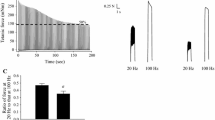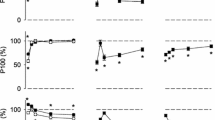Abstract
This study investigates early adaptive responses of fast-twitch muscle to increased contractile activity by low-frequency stimulation. Changes in metabolite levels and activities of regulatory enzymes of carbohydrate metabolism were investigated in rabbit tibialis anterior muscle after 24 h of stimulation. In addition, changes elicited during a 5-min lasting acute stimulation experiment were compared between 24-hprestimulated and contralateral control muscles. Stimulation for 5 min reduced energy-rich phosphates and glycogen, and increased lactate in the control muscle. A transient elevation of fructose 2,6-bisphosphate demonstrated that activation of phosphofructokinase 2 was an immediate response to contractile activity. Prestimulated muscles displayed nearly normal values for ATP, phosphocreatine and glycogen, and did not augment lactate. Increased activities of hexokinase and phosphofructokinase 2 and permanently elevated levels of fructose 2,6-bisphosphate pointed to enhanced glycolysis with glucose as the main fuel in the prestimulated muscle. Isometric tension of the control muscle decreased rapidly a few minutes after the onset of stimulation. In the prestimulated muscles, tension was almost stable, but amounted to only 30%–40% of the initial tension of the control muscle. In view of the fibre type distribution of rabbit tibialis anterior, these findings suggested that a large fibre fraction of the prestimulated muscle, possibly the glycolytic type IID fibres, did not contract. Therefore, the possibility must be considered that the metabolite pattern of the 24-h-stimulated muscle primarily reflected metabolic activities of the contracting, less fatigable fibres, most likely type IIA and type I fibres. The suggestion that a large fibre fraction did not produce force, in spite of metabolic recovery, points to factors responsible of their refractoriness to low-frequency stimulation other than metabolic exhaustion.
Similar content being viewed by others
References
Aigner S, Gohlsch B, Hämäläinen N, Staron RS, Uber A, Wehrle U, Pette D (1993) Fast myosin heavy chain diversity in skeletal muscles of the rabbit: heavy chain IId, not IIb predominates. Eur J Biochem 211: 367–372
Bass A, Brdiczka D, Eyer P, Hofer S, Pette D (1969) Metabolic differentiation of distinct muscle types at the level of enzymatic organization. Eur J Biochem 10: 198–206
Bassols AM, Carreras J, Cusso R (1986) Changes in glucose 1,6-bisphosphate content in rat skeletal muscle during contraction. Biochem J 240: 747–751
Beitner R (1990) Regulation of carbohydrate metabolism by glucose 1,6-bisphosphate in extrahepatic tissues; comparison with fructose 2,6-bisphosphate. Int J Biochem 22: 553–557
Bradford MM (1976) A rapid and sensitive method for the quantitation of microgram quantities of protein utilizing the principle of protein-dye binding. Anal Biochem 72: 248–254
Bücher T, Rüssmann W (1964) Equilibrium and nonequilibrium in the glycolysis system. Angew Chem Int Ed Engl 3: 426–439
Cadefau J, Casademont J, Grau JM, Fernandez J, Balaguer A, Vernet M, Cusso R, Urbano-Marquez A (1990) Biochemical and histochemical adaptation to sprint training in young athletes. Acta Physiol Scand 140: 341–351
Carroll NV, Longley RW, Rose JH (1956) The determination of glycogen in liver and muscle by use of anthrone reagent. J Biol Chem 193: 583–592
Dux L, Green HJ, Pette D (1990) Chronic low-frequency stimulation of rabbit fast-twitch muscle induces partial inactivation of the sarcoplasmic reticulum Ca2+-ATPase and changes in its tryptic cleavage. Eur J Biochem 192: 95–100
El-Maghrabi MR, Claus TH, Pilkis J, Pilkis SJ (1982) Regulation of 6-phosphofructo-2-kinase activity by cyclic AMP-dependent phosphorylation. Proc Natl Acad Sci USA 79: 315–319
Gilboe DP, Larson KL, Nutall FQ (1972) Radioactive method for the assay of glycogen phosphorylase. Anal Biochem 47: 20–27
Green HJ, Düsterhöft S, Dux L, Pette D (1990) Time dependent changes in metabolites of energy metabolism in low-frequency stimulated rabbit fast-twitch muscle. In: Pette D (ed) The dynamic state of muscle fibres. de Gruyter, Berlin New York, pp 617–628
Green HJ, Cadefau J, Pette D (1991) Altered glucose 1,6-bisphosphate and fructose 2,6-bisphosphate levels in low-frequency stimulated rabbit fast-twitch muscle. FEBS Lett 282: 107–109
Green HJ, Ball-Burnett M, Chin ER, Dux L, Pette D (1992) Time dependent increases in Na+,K+-ATPase concentration of low-frequency stimulated rabbit muscle. FEBS Lett 310: 129–131
Green HJ, Düsterhöft S, Dux L, Pette D (1992) Metabolite patterns related to exhaustion, recovery, and transformation of chronically stimulated rabbit fast-twitch muscle. Pflügers Arch 420: 359–366
Hämäläinen N, Pette D (1993) The histochemical profiles of fast fiber types IIB, IID and IIA in skeletal muscles of mouse, rat and rabbit. J Histochem Cytochem 51: 733–743
Katz A, Broberg S, Sahlin K, Wahren J (1986) Leg glucose uptake during maximal dynamic exercise in humans. Am J Physiol 251: E65-E70
Leberer E, Pette D (1984) Lactate dehydrogenase isozymes in type I, IIA and IIB fibres of rabbit skeletal muscles. Histochemistry 80: 295–298
Leberer E, Pette D (1986) Immunochemical quantitation of sarcoplasmic reticulum Ca-ATPase, of calsequestrin and of parvalbumin in rabbit skeletal muscles of defined fiber composition. Eur J Biochem 156: 489–496
Leberer E, Härtner K-T, Pette D (1987) Reversible inhibition of sarcoplasmic reticulum Ca-ATPase by altered neuromuscular activity in rabbit fast-twitch muscle. Eur J Biochem 162: 555–561
Lowry OH, Passonneau JV (1972) A flexible system of enzymatic analysis. Academic Press, New York London
Matsushita S, Pette D (1992) Inactivation of sarcoplasmic reticulum Ca2+-ATPase in low-frequency stimulated muscle results from a modification of the active site. Biochem J 285: 303–309
Matsushita S, Dux L, Pette D (1991) Distribution of active and inactive (nonphosphorylating) sarcoplasmic reticulum Ca2+-ATPase molecules in low-frequency stimulated rabbit fast-twitch muscle. FEBS Lett 294: 203–206
Passonneau JV, Lowry OH, Schulz DW, Brown JG (1969) Glucose 1,6-diphosphate formation by phosphoglucomutase in mammalian tissues. J Biol Chem 244: 902–909
Pette D (1991) Effects of chronic electrostimulation on muscle gene expression. Semin Thorac Cardiovasc Surg 3: 101–105
Pette D, Düsterhöft S (1992) Altered gene expression in fast-twitch muscle induced by chronic low-frequency stimulation. Am J Physiol 262: R333-R338
Pette D, Vrbová G (1992) Adaptation of mammalian skeletal muscle fibers to chronic electrical stimulation. Rev Physiol Biochem Pharmacol 120: 116–202
Pette D, Ramirez BU, Müller W, Simon R, Exner GU, Hildebrand R (1975) Influence of intermittent long-term stimulation on contractile, histochemical and metabolic properties of fibre populations in fast and slow rabbit muscles. Pflügers Arch 361: 1–7
Reichmann H, Hoppeler H, Mathieu-Costello O, von Bergen F, Pette D (1985) Biochemical and ultrastructural changes of skeletal muscle mitochondria after chronic electrical stimulation in rabbits. Pflügers Arch 404: 1–9
Reichmann H, Wasl R, Simoneau J-A, Pette D (1991) Enzyme activities of fatty acid oxidation and the respiratory chain in chronically stimulated fast-twitch muscle of the rabbit. Pflügers Arch 418: 572–574
Schwarz G, Leisner E, Pette D (1983) Two telestimulation systems for chronic indirect muscle stimulation in caged rabbits and mice. Pflügers Arch 398: 130–133
Termin A, Staron RS, Pette D (1989) Changes in myosin heavy chain isoforms during chronic low-frequency stimulation of rat fast hindlimb muscles — a single fiber study. Eur J Biochem 186: 749–754
Thomas SA, Schlender KK, Larner J (1968) A rapid filter assay for UDP-glucose glucosyltransferse, including an improved biosynthesis of UDP-(14C)glucose. Anal Biochem 25: 486–499
van Schaftingen E, Lederer B, Bartrons R, Hers HG (1982) A kinetic study of pyrophosphate: fructose 6-phosphate phosphotransferase from potato tubers. Eur J Biochem 129: 191–195
Weber FE, Pette D (1990) Changes in free and bound forms and total amount of hexokinase isozyme II of rat muscle in response to contractile activity. Eur J Biochem 191: 85–90
Wegener G, Krause U, Thuy M (1990) Fructose 2,6-bisphosphate and glycolytic flux in skeletal muscle of swimming frog. FEBS Lett 267: 257–260
Author information
Authors and Affiliations
Rights and permissions
About this article
Cite this article
Cadefau, J.A., Parra, J., Cussó, R. et al. Responses of fatigable and fatigue-resistant fibres of rabbit muscle to low-frequency stimulation. Pflügers Arch. 424, 529–537 (1993). https://doi.org/10.1007/BF00374918
Received:
Revised:
Accepted:
Issue Date:
DOI: https://doi.org/10.1007/BF00374918




